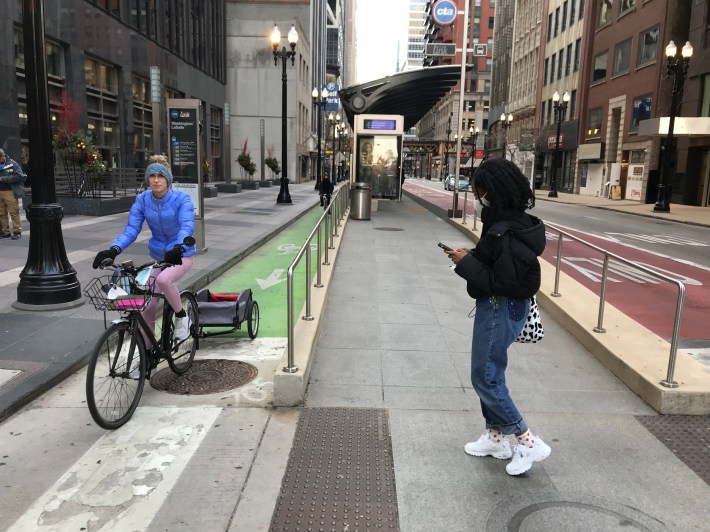Update 12/22/21: The Chicago Department of Transportation provided additional info on the Clark Street plans:
"Over the next few weeks, we are planning to add a number of additional [flexible plastic posts] to help clearly demarcate the bike lane and make it clear that parking is not allowed.
In addition:
- Next year, we are working on plans to add concrete protection – and eight bus boarding at locations along the stretch.
- We are working on a design for 8 bus boarding islands on Clark Street along with the concrete upgrades.
- Boarding islands will improve transit operations, allow people biking to ride behind the bus stop with no bus merging, and not allow people park in the bus stop

We think these new bike lanes are a big improvement over what was there before, but we understand there has been a learning curve for some drivers."
As Streetsblog readers know, the protected bike lanes the Chicago Department of Transportation installed last summer on Clark Street between Hollywood Avenue (5700 North) and Devon Street (6400 North) in Edgewater have been only semi-functional, because drivers constantly park in them. Streetsblog previously called for redesigning the lanes to make them harder to illegally park in.

The sustainable transportation advocacy group Better Streets Chicago, which I cofounded, launched an email campaign that resulted in more than 200 letters being sent to CDOT and local aldermen Andre Vazquez (40th) and Harry Osterman (48th), asking them to fix the lanes. The group also requested updates as to what design changes would be made.
These lobbying efforts seem to have gotten results. Today Vasquez shared this update on the bikeway situation on Twitter.
@chi_streets @streetsblogchi @activetrans @FullLaneFemme @bikelaneuprise pic.twitter.com/0XLSM1SQrU
— Andre Vasquez, Political Account 🌹 (@Andrefor40th) December 21, 2021
Vasquez’s statement began by acknowledging that ever since the Clark lanes were installed, his office has been contacted by residents pointing out that the constant bike lane obstructions are a hazard for people on bikes. He said two weeks after the lanes were finished, flyers were posted to inform neighbors about the new parking layout and restrictions, and to let them know that illegally parked vehicles would be ticketed.
After two weeks, Vasquez asked the Department of Finance to start writing tickets. He also instructed the department to tow vehicles when necessary in order to keep the lanes clear.
The alderman added that he met with Commissioner Biagi and the CDOT bike team to request more protection for the bike lanes, “specifically making the case that we need to see concrete or Qwick Kurb, a temporary barricade that is typically bolted to the street. I also asked that they look at the 5800, 5900, and 6100 North blocks of Clark to see what adjustments might be made there.”

Vasquez said CDOT committed to (his words):
- "Installing extra [flexible plastic posts] every 20 feet instead of every 40 feet by the end of the month, so that it is harder for [drivers] to pass in between them to park in the bike lane. I also asked if it’s possible to add [posts] at intersections to narrow the bike lane, making it difficult for cars to pass in that way also."
- "Installing a concrete curb to protect the bike lane in 2022 when the weather permits (This would be funded by the federal infrastructure bill that was passed, along with the 2021 city budget.)"
- "Making necessary and feasible adjustments to the 5800, 5900, and 6100 block of North Clark Street."
- "Additionally, there is talk of installing bus stop bulbs at some intersections with the bike lane with associated changes in bike infrastructure there to further protect cyclists.”
Vasquez ends with, “Here in the 40th ward, we take traffic safety seriously, and I am grateful for the partnership of Alderman Osterman (48th), CDOT, and most importantly the neighbors and bike advocate such as Better Streets Chicago, Active Transportation Alliance, and more who were vocal and organized in joining us to make this a priority!”
Precast concrete curbs could be installed today, cheaper, and adaptable to needs. pic.twitter.com/PccvFtm8JI
— How to stop driving: Bike, walk, transit once/week (@JustinHaugens) December 21, 2021
It's encouraging to see that grassroots efforts by advocates helped light a fired under city officials to make needed changes. However, one tweak to the plan that we'd suggest is that there's no need to wait until spring to add concrete protection. As local bike advocate Justin Haugens pointed out on Twitter, above, CDOT could start improving safety for cyclists immediately by installing precast concrete curbs.





